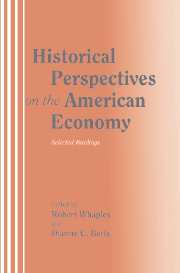Book contents
- Frontmatter
- Contents
- Acknowledgments
- Introduction to students
- Introduction to instructors
- Contributors
- I Introduction
- II Colonial and early national economy
- III Slavery and servitude
- IV The South since the Civil War
- 8 “The trap of debt peonage”
- 9 “The economic revolution in the American South”
- V The rise of American industrial might
- VI Populism
- VII Women in the economy
- VIII The Great Depression
- Appendix: Basics of regression
- Glossary
- Name index
- Subject index
9 - “The economic revolution in the American South”
Published online by Cambridge University Press: 05 June 2012
- Frontmatter
- Contents
- Acknowledgments
- Introduction to students
- Introduction to instructors
- Contributors
- I Introduction
- II Colonial and early national economy
- III Slavery and servitude
- IV The South since the Civil War
- 8 “The trap of debt peonage”
- 9 “The economic revolution in the American South”
- V The rise of American industrial might
- VI Populism
- VII Women in the economy
- VIII The Great Depression
- Appendix: Basics of regression
- Glossary
- Name index
- Subject index
Summary
As recently as twenty-five years ago, regional economic backwardness in the states of the traditional American South was considered an intractable problem of continuing national concern. Poverty and economic stagnation seemed rooted in Southern culture, the same culture which maintained segregation and traditional race relations. The eminent historian of the South, C. Vann Woodward, wrote in 1961: “The modern South rests on these very foundations and is continuous in its economic, political, and racial institutions and doctrines with the order established in 1877. … In racial policy, political institutions and industrial philosophy, there has been no break with the founding fathers of the New South” (Woodward, 1961, p. E3).
Obviously, much has changed since then. But as the attention of economists has been taken up by new sets of concerns, like energy, inflation, and the competitive position of American manufacturing centers in the Northeast and Midwest, not many have stopped to look back and ask why the perception and reality of the Southern economy has changed so drastically in such a short time. Those who do look back over a longer period often imply that the rise of the South was essentially a long-term process of national convergence in factor prices and per capita incomes; that is, a gradual but reasonably steady reflection of basic economic forces which are relatively well understood by economists.
Even on its own terms, this level of understanding is unsatisfactory. If regions have converged in recent years, why did they diverge initially?
- Type
- Chapter
- Information
- Historical Perspectives on the American EconomySelected Readings, pp. 293 - 314Publisher: Cambridge University PressPrint publication year: 1995



